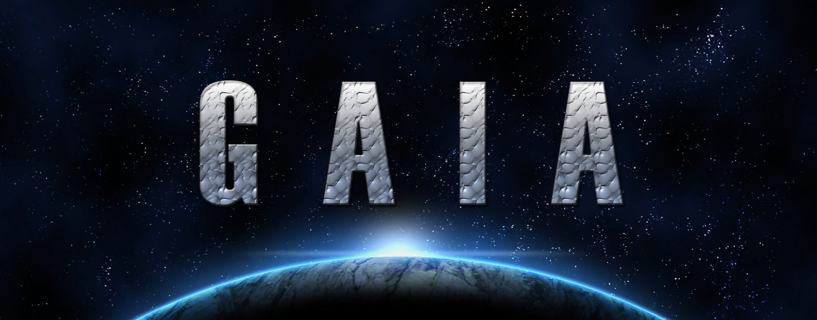Survival-crafting on humanity’s ancestral homeworld, or something like that, anyway.
Type: Single-player
Genre: Action, Adventure,
RPG, Simulation, Strategy
Developer: Radu Saghin
Publisher: Radu Saghin
Release Date: 31 May, 2019


Introduction and Marketing
Gaia is the first game on Steam from one-man indie, Radu Saughin. It’s the latest game to enter Steam Early Access in the seemingly endless stream of survival-crafting PC games on the platform, which is not to say said stream of releases is a bad thing. It’s not; I just wish I had more time to play them all!
The background story is somewhat interesting, if not entirely fleshed out and realised by the game in its current form. The game is set some time in the distant future. You play Amanda, a galactic-treasure-hunting human in search of Gaia, the planet from which humanity apparently originally came. Something goes awry with your ship while you’re on approach to the planet and you crash in your escape pod, a crate of emergency supplies, a rifle, a rather nifty mining tool (which looks like it could have come straight out of Project Nomads, but apparently wasn’t influenced by it at all), and your trusty PDA your only tools to survive in the lovely green wilderness.
From here the Kickstarter campaign stated that “you will decide how the story continues and ends”, but at the moment, at least, there really only seems to be one goal: to build another space ship and escape the planet, potentially picking up some artefacts from “the ancients” along the way. There’s actually not that much to do outside of this, at least when compared to many other games in the genre. Of course, options will most likely be expanded as the game progresses through Early Access.
The Kickstarter campaign also claimed that “Gaia is its own genre as it was inspired from a bunch of totally unrelated games, such as Rimworld, tower defense games, RPG’s like Skyrim and survival games like Subnautica. You could describe it as a RPG, survival base building game.” (sic) Though some of the influences are obviously there, I don’t see it as being its own genre at all; it fits pretty neatly alongside most other survival-crafting games out there at the moment. Apart from one very obvious influence and the title screen and music it’s nothing like RimWorld, and its connections to RPGs or tower-defence games are tenuous at best. Again, that’s not necessarily a bad thing — I like modern survival-crafting games immensely — it’s just not quite what I expected from the marketing material. Perhaps there are more drastic divergences from the survival-crafting norm planned for future development.
Presentation: The Quintessential Mixed Bag
Gaia’s presentation is all over the place!
The developer realises this, I know, and has stated in the Early Access spiel on Steam that many of the visual assets in particular are placeholders: publicly available assets used in the game until (assuming the game is successful enough to warrant the cost) artists can be hired to produce better, custom-made ones. But while sometimes it does look rather naff, it’s not really as bad as it sounds.
To start, the title screen is pretty. After that, once you’ve got through the admittedly rather poorly rendered escape pod interior and landed on the planet, the world itself looks quite nice, too. Trees look good, with detailed foliage and great shadows, though there aren’t enough different models to make them convincing. Time-of-day- and weather- based lighting effects are mostly fitting, and most of the animal and “monster” models look pretty nice, too, though there are a number of janky animations and many of them look out of place, with chickens, cows, and pigs alongside creatures straight out of a fantasy game: barghests and giant scorpions. And for all that, the world just seems so darn empty! For a game world with such large open spaces, the view distance is also too short even with all graphics options turned up to 11, leaving everything looking artificially foggy. Meteor showers also look rather dodgy.
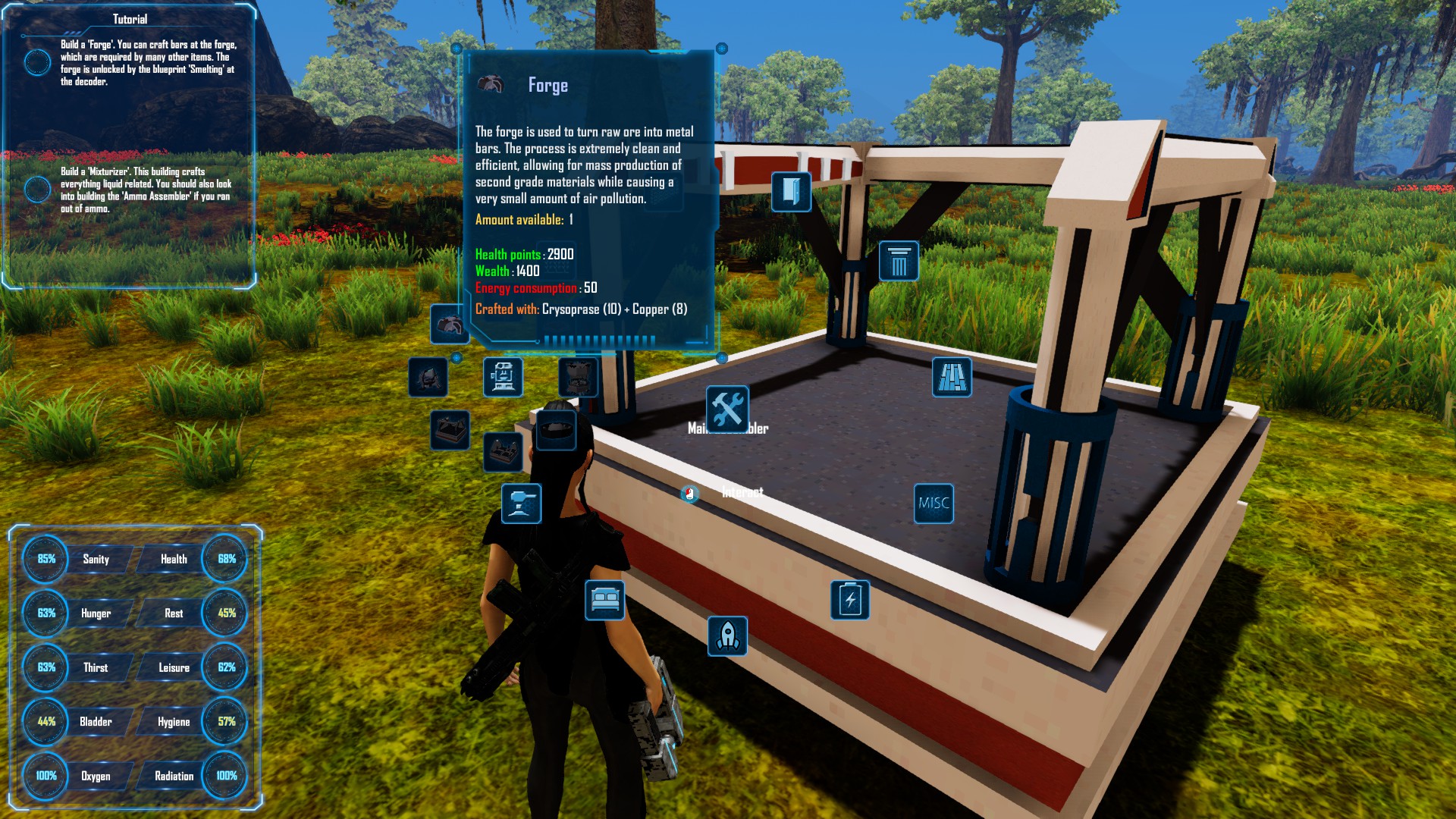
The player character model isn’t too bad, though nowhere near as pleasant to look at as, say, a Conan: Exiles character, and movement is let down by more unconvincing animations and terrain-following issues. The lack of a somewhat-independently controllable third-person camera (“v” in Conan: Exiles) is disappointing, too, though it’s not necessarily a staple of the genre.
Other models look like true programmer art, with most of the constructed components and modules resembling little more than vague geometric shapes with plain textures; these really look out of place! Some interface components, too — most notably the PDA — look rough and unfinished. Some lighting effects look wrong, too, and rain splashes are far too noticeable, causing what look like little static discharges where the rain falls on surfaces. Clouds are often pixelated, though the moon looks impressive (if slightly too sharp-edged) as it rises and moves across the sky, seemingly close enough to touch.
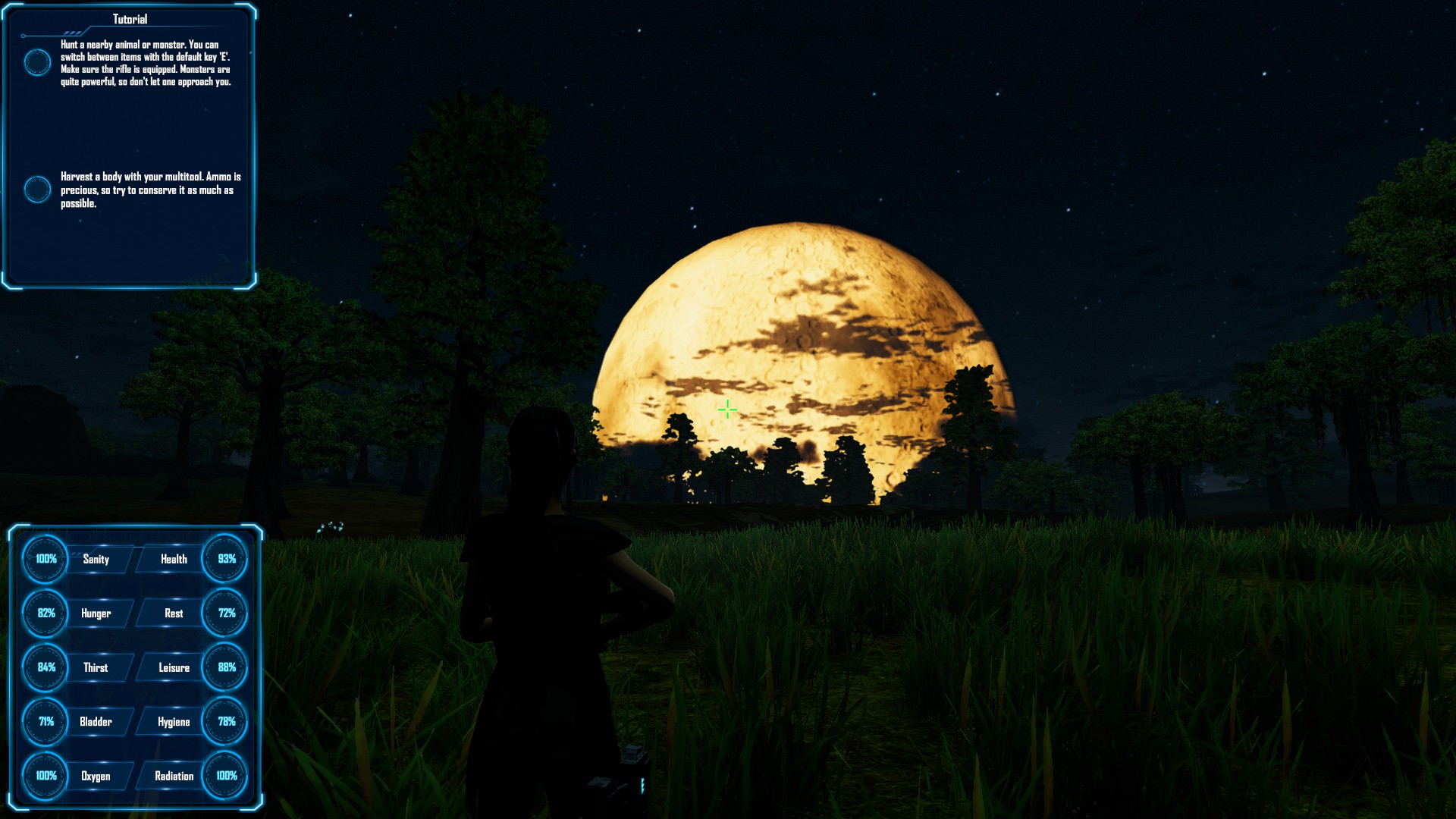
Sound effects are of variable quality and use, but are mostly not too bad. Gunfire is awfully loud (possibly on purpose) and the minigun turrets don’t sound like miniguns at all. Footsteps seem too loud — especially for chickens! — and the insect sounds seem rather prominent for an environment in which there seem to be no insects. It’s a good start, though, I suppose. Music is, for the most part, lovely, with the title music probably the best of the tracks. A few tracks seem a bit loud and I haven’t worked out what causes them to play, or if it’s just a timer or pseudo-random event that triggers it. Volume is independently adjustable, in any case.
The game features some voice “acting”, which is currently done by a fairly rudimentary text-to-speech component. Though this voice does represent Amanda’s PDA AI, so an electronic voice is at least somewhat suitable, I can’t help but feel that it doesn’t really fit the setting; I’d expect computers in the far future to sound a little better. This, too, though is a placeholder; one of the goals of the original Kickstarter campaign was to include some professional voice acting.
Interface Woes
Controls and the user interface are perhaps two of the game’s weaker points in the current alpha release. I simply can’t get used to the default control layout and have attempted to map the controls to those used by most other games in the genre. Not all of these controls can be remapped, either. The worst culprit is using LMB both for attack and to interact with objects. What a terrible idea! Use “e” for interact like everyone else does! With the current, unchangeable layout, you’ll invariably end up shooting something you’re trying to use or operate. Generally, unless there’s a good reason, going against the commonly accepted controls or conventions of other similar games is a bad idea; it just creates dissonance and makes the game harder to like.
There’s also some missing functionality that I’d imagine most fans of the genre will feel should be there: there’s no hotbar for quick item use and no “loot all” option or button when interacting with containers — everything has to be dragged one item at a time — and there’s only very limited object stacking: each unit of a resource takes up its own slot!
Speaking of the interface, there’s too much screen space used up on the left with survival-related values. These should be hidden most of the time in my opinion; they certainly don’t warrant taking up that much real estate permanently, in any case. And I have to say I absolutely hate progress bars that fill up from left to right … then empty again and refill, over and over. Gaia’s loading bar is one of these. I want to kill it. (Note to Dev: Please replace it with a true progress bar that indicates loading is finished when the bar is full, or with something that doesn’t look like a progress bar at all!) Loading and quitting times are very long, with no good indication of time remaining.
Grammar and writing are mostly good, if a little informal in places, but I did see a few typos and other little grammatical oddities here and there. I’d hope all the in-game text will go through an editing pass before the final release. The font in some areas (e.g. “tips”) is way too compact to read comfortably; an increase in point size or different font would do wonders for readability.
Core Gameplay
Gaia’s basic gameplay loop will be immediately familiar to anyone who’s played any recent survival-crafting game. You begin with a small amount of equipment and have to harvest basic resources in order to build crafting stations that allow you to craft other modules and create tier-2 resources, in order to craft other modules. You can do some research (here wrapped up in the concept of “decoding” technologies that are encoded in your PDA for security reasons), unlocking extra recipes and modules, and there’s some very basic base building as well. The end goal appears to be to build a spaceship to leave the planet — preferably after having found the technology of the Ancients, since that’s the whole reason you were here in the first place, but on the way you’ll have to fight with the planet’s native creatures and most likely other human raiders searching for the Ancient technology as well.
Gaia does all of this in a fairly standard manner, with only limited research currently available (17 items, four of which are directly related to the end-game spaceship) and extremely basic single-level base building. Combat is extremely simple and extremely limited by ammunition availability; it would be much more enjoyable if ammunition were more plentiful and it didn’t take a bazillion shots from your rifle to kill a chicken (a slight exaggeration, I confess). Working melee combat would be even better! There’s also not that much of interest to actually build; it all seems to be relatively linear at the moment, progressing towards the point where you can escape, with only a few options along the way.
The world is big, but mostly very empty with nothing to do, and with no map it’s hard to see where you are with respect to it, or find your way back to previously explored locations. Based on the new game options, there appear to be three different map topologies, but there’s some procedural generation going on here as well, at least with regard to resource and creature locations. I’ve played a few different times on the same map and haven’t seen any familiar places yet, anyway.
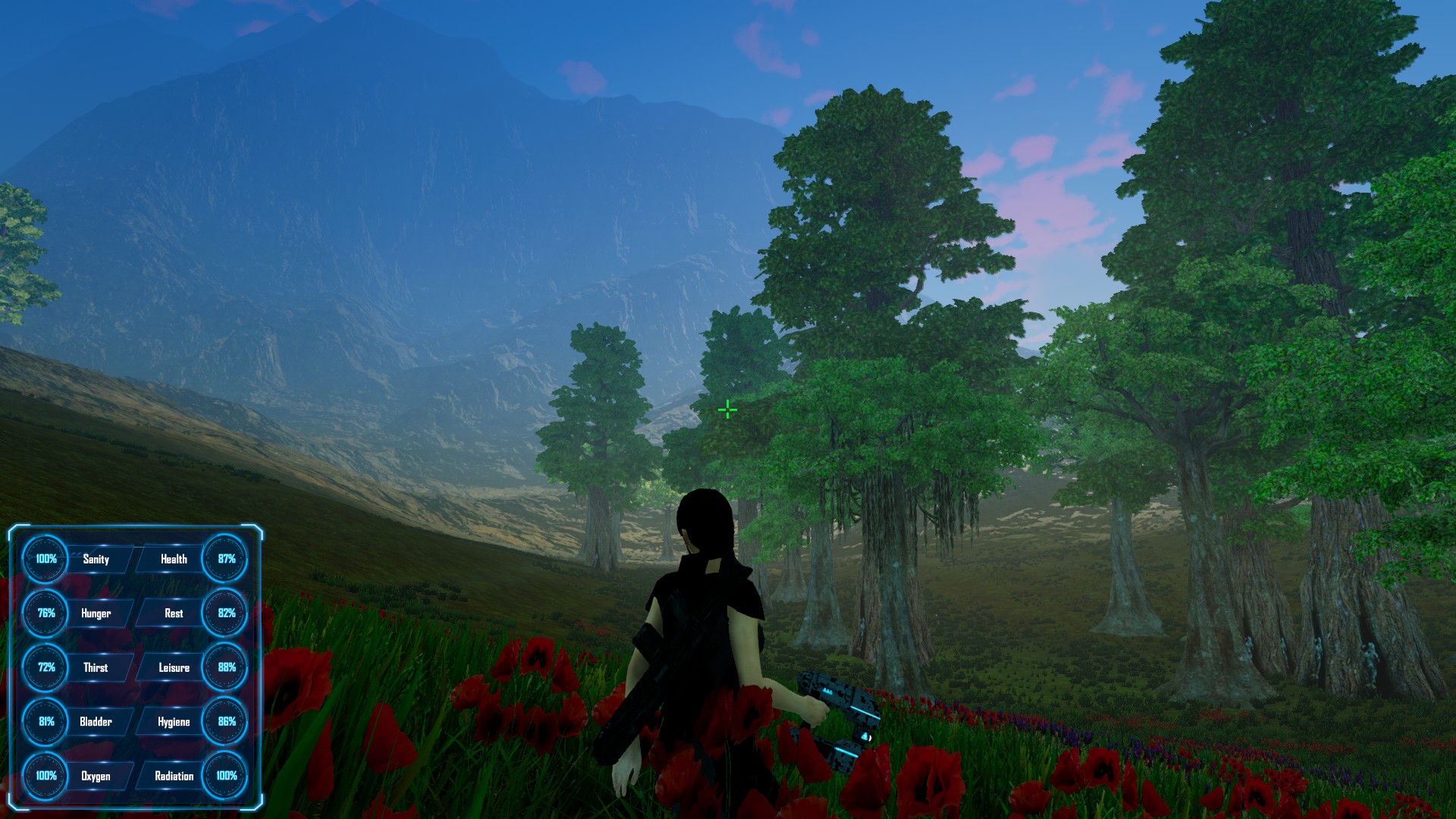
I believe there are (or will be?) caves to explore as well. I haven’t seen any of these yet, though I did go exploring for some time looking for one. I’ve run from one side of the map (endless water) to the other (endless water) and found no reason to do so again, at least not until some more content has been added.
Intelligent Artificial Intelligence?
I’ve seen a few mentions of Gaia featuring “intelligent AI” (isn’t that a tautology?), but ultimately I haven’t seen anything any different to most other survival crafting games, or even open world games in general: aggressive creatures attack you on sight or when you enter certain areas, while scared creatures run away and neutral creatures leave you alone as long as you do the same with them. In fact, at the moment the AI seems particularly simple; it doesn’t have any special use or comprehension of terrain and doesn’t seem to take any special notice of numbers to try to surround or trap Amanda, or do anything much more than run at Amandar or away from her.
The game also features three “AI storytellers”, an obvious RimWorld influence. These are separate to the overall difficulty level, but ultimately contribute to it, and in description, at least, are all but direct copies of those from RimWorld. The first gradually builds up difficulty in a predictable manner as you play, the second gives you long periods of calm progression only occasionally interrupted by events, and the third is chaotic. The “storytellers” only seem to have a handful of obvious tools at their disposal: some random events such as radioactive clouds or meteor storms, and raids on your base, though it’s certainly possible that there’s more available to them behind the scenes (or there will be soon).
While exposing these to the player at creation of a new game in the RimWorld style is new to the genre, much of what they do is usually packaged up and hidden under difficulty options or server configurations in other games, so I can’t really credit it as being a genre-changing addition. It’s interesting to see, but ultimately ends up feeling like a more limited version of setting up the server configurations to your liking in one of the more established survival-crafting games. Perhaps more will be done with it in future.
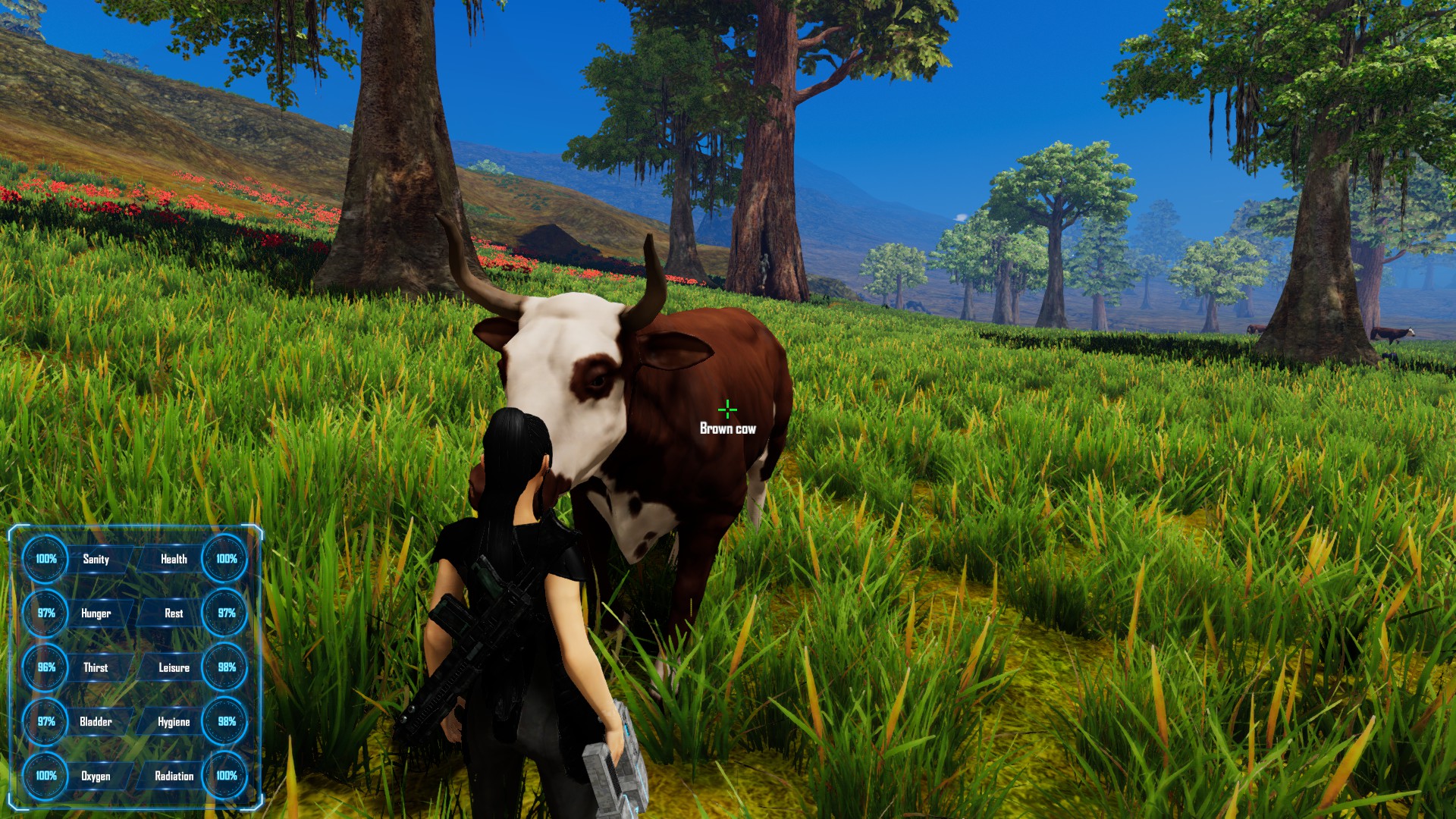
Do Big, Scary Wolf-creatures Really Care about Wealth?
Building and harvesting adds to your overall “wealth” stat, which apparently increases the frequency of raids on your base. Before a raid, your PDA AI alerts you of ground forces that appear to be gathering for an attack (how does it know, really; and if it can detect them, why can’t it do a better job of showing you information about your surroundings!?), then after a set amount of time the creatures charge at you, attacking suicidally until either you or they are dead.
If you’ve managed to research and build the right things you’ll have a gun turret or two ready by this stage, positioned strategically amongst defensive walls to take out the approaching enemies. But as with your own personal rifle, you’ll want to keep them well stocked with ammunition — and also make sure you have enough power generation at your base to power the rather energy-hungry turrets. And there’s little opportunity for creative placement or clever tactics, given the restricted building options at your disposal and the relatively simple AI.
These situations are probably where the stated connection to the tower-defence genre arises, but really, it’s very tenuous. There are none of the normal tower-defence systems or gameplay at work here; you’re just building a base with defensive items the same as with most other survival crafting games. It’s just much simpler in Gaia.
So far I’ve only been raided by non-humanoid creatures that I don’t imagine would care about my wealth, so the whole wealth thing seems a bit illogical in these cases at least, though the mentioned humanoid raiders might make a bit more sense. In any case, as a game mechanic this works similarly to the purge meter from Conan: Exiles, but I don’t think there’s a minimum wealth level required to trigger a raid.
She’s Crazy as a Coconut
Survival aspects are slightly more detailed than many other games, but not really in a very complex or interesting way. The typical food and water gauges are expanded to include leisure, rest, bladder, hygiene, and other Sims-like attributes, each of which has a set action or object or group thereof to satisfy it: sit down to regain leisure, sleep (but only on bare ground!) to regain rest, “poop” (I kid you not) to regain bladder, and so on.
One of the more original aspects of Gaia is the system that adds certain penalties as these survival gauges decrease. Don’t eat enough and your maximum health drops. Get too thirsty and you start to dehydrate, causing weird visual effects. Let your bladder meter go too low and your maximum movement speed will decrease. And so on. When a number of your gauges are low enough for long enough, your sanity gauge will decrease. Once your sanity gauge reaches certain thresholds Amanda starts to behave erratically, seeing ghostly images that distract you and dropping random items from her inventory.
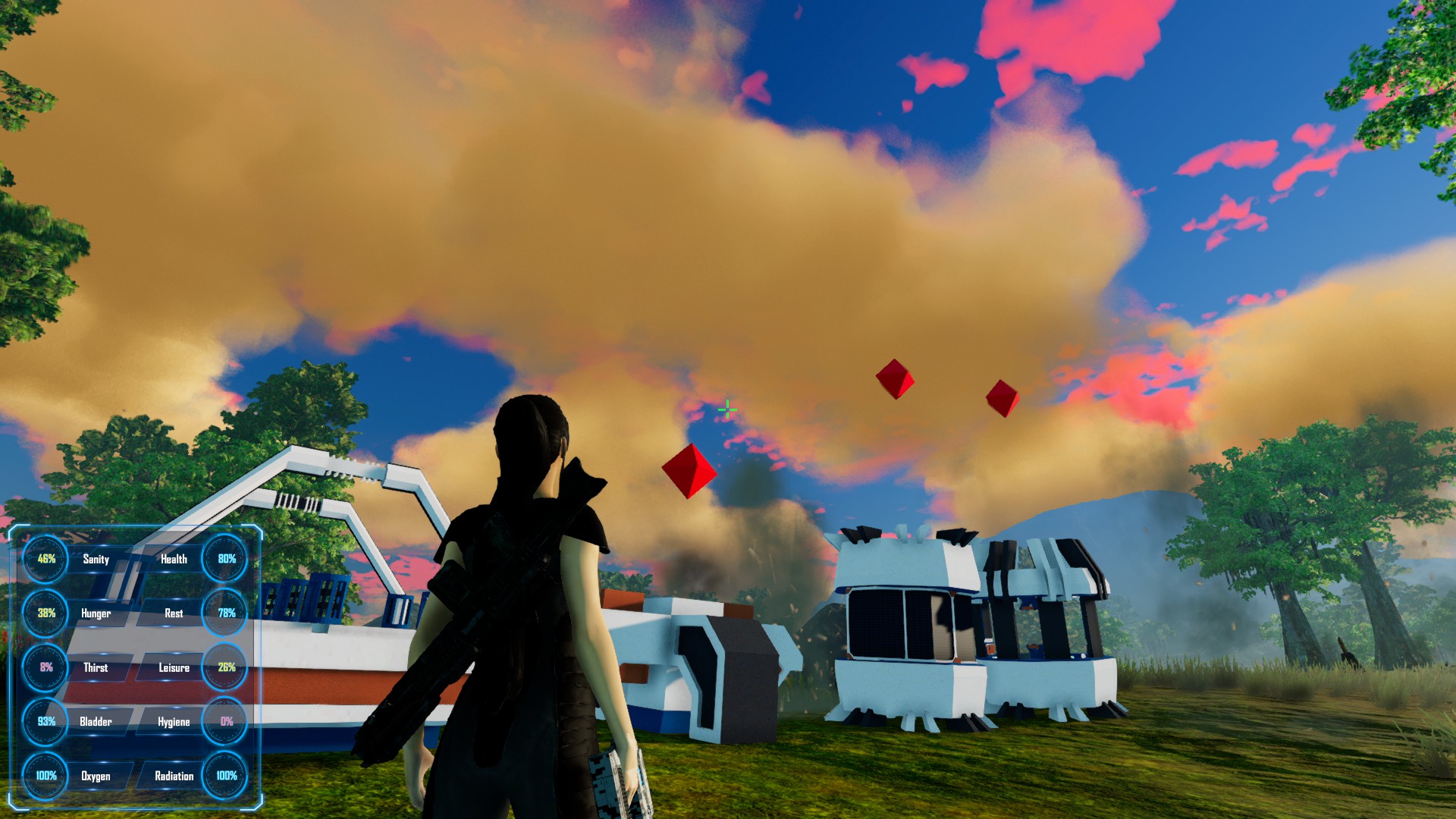
The effects are mostly fairly minor, but the groundwork is here for an interesting addition to the typical survival-crafting systems. Rather than adding to the experience at the moment, though, I’ve found most of these to simply be annoying distractions from what I’m trying to achieve. The gauges all decrease far faster than they should — you’ll notice hunger and thirst will probably have dropped by 10% or so by the time you even step outside of your escape pod — and satisfying them is simply a chore: more grind for no reward.
Bring DEET — Lots of DEET
One of the “charms” of playing an indie Early Access game is the opportunity to encounter new and unusual bugs in games, many of the kind or severity that would almost certainly be removed by a QA team on a larger project with a big publisher. Gaia certainly doesn’t fail to deliver here, being one of the more bug-ridden EA games I’ve had the opportunity to play. While I expect most of these to be fixed during the game’s journey through Early Access, I’d also expect more to appear. While a development team of one allows the developer to know all of the code better than might be expected of a single developer in a larger team, there are also only so many ways a single person can look at the code, test it, and play it.
Some of the game-breakers included an early problem (now fixed!) with saved games being allowed to include spaces in the filenames, but the loading system not being able to read them back again; turrets sometimes simply stopping shooting, leaving you defenceless in the face of a raid; and bugs with melee combat, or maybe not. I’d better explain that last one. I can’t work out whether the game is supposed to allow you to cause damage to creatures with anything other than your rifle. At first, I assumed not, but then in one game a creature disappeared when I “attacked” it with my mining device, allowing me to survive a raid — around 30:30 in my video, above, in fact. Watching the video again I’m pretty sure it’s a bug that the creature disappeared, and actually there’s no way to damage anything unless you have ammunition, which is a terrible design decision in a game in which ammunition is so expensive to build and you need so much. (Not to mention it not making any sense!)
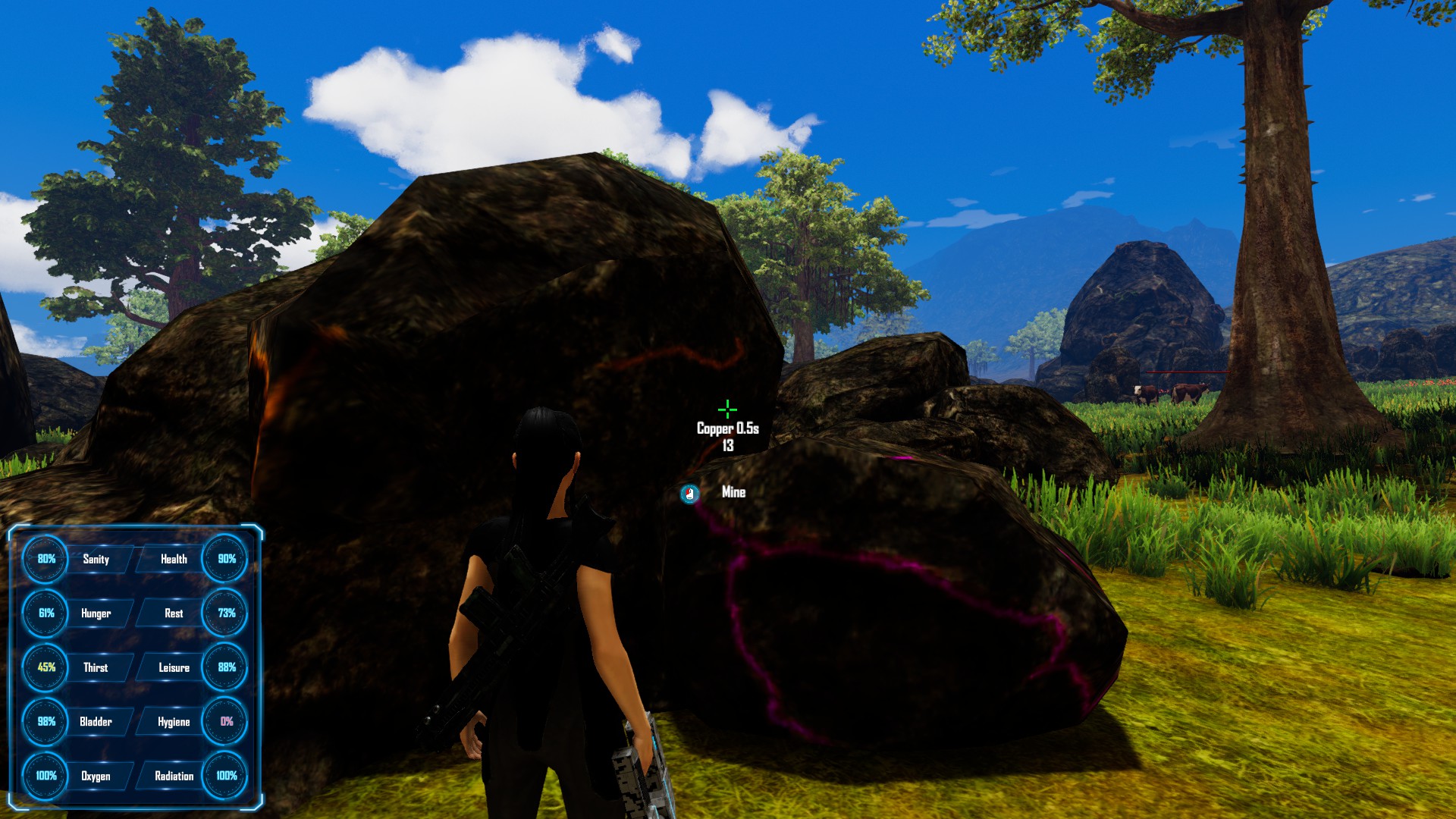
Speaking of questionable design decisions and confusing game systems, I’ve also been unable to work out whether resources (plants, mineral rocks, etc.) respawn in the same place, in a pseudo-random position, or not at all. Survival-crafting games with hard limits on resources (i.e. no respawning) effectively place a time limit on gameplay while also preventing you from doing some cool stuff, like building massive bases or lots of little outposts. As you may be able to tell, I think that’s another terrible idea. I don’t know if this is what’s been implemented with Gaia, though. I thought I’d seen a couple of previously harvested resource nodes repopulate again, but in trying to confirm this I’ve spent hours revisiting previously mined areas in one game and have not seen any nodes respawn. So, there’s either a serious bug concerning resource spawning or there’s a design decision that I’d really like to see revisited.
Other much less serious bugs include the escape menu — seemingly a pause menu, as in most other games — not actually pausing the game (ProTip: “Save or Quit” if you need a short break in real life; don’t leave the game “paused”, because, well, it’s not); the much-vaunted “intelligent AI” getting stuck on terrain, the same way the player character can far too easily; glitchy building issues that prevent placement of walls, supports, windows, etc, where there is open space that should allow it; “can only sleep on ground” when trying to sleep on the floor; “You’ve died. Ironman game over” displayed with a button that doesn’t work after an ironman death, requiring alt-tab to close or restart; and occasionally not being able to interact with any in-game objects until opening and closing the Escape menu or PDA. All the usual EA sort of stuff, in other words, and probably not much to worry about in the long term, at least.
Permadeath is Cool, or not
Permadeath is one of those game features that divides gamers like an in-game shop. I love permadeath in games. I’m a fan of early Rogue-like games, having spent more hours than I’d like to count playing Nethack and Angband, and numerous variants, and continue to enjoy many modern games that implement Rogue-like features, with permadeath and procedural generation being top amongst them. But permadeath hard to do right.
I don’t mean technically, of course; it’s pretty easy when you think about it. But it’s hard to find the right game in which to implement permadeath and have it actually add something to the game that’s worthwhile. And even if you find the right game, it’s hard to know how to structure it, how to tie permadeath into the gameplay and the load/save system, and all the other components that make up the game as a whole. Gaia has a mode called “Ironman mode”, which removes the ability to save manually and reload, and implements permadeath. It really shouldn’t.
Survival crafting is a genre that requires a lot of time and patience and repetition. In the best and most successful games of the genre, it also involves dying a lot. People play these games for hundreds, even thousands of hours, often spent in a single game instance. In order for permadeath to be a suitable game design element it has to be implemented in such a way that a single mistake won’t cost the player tens, hundreds, or thousands of hours of his or her real life. Although Gaia doesn’t currently have anywhere near enough content to keep most survival-crafting aficionados busy for that long, I think its content offering is going to have to expand significantly if it wants to succeed in the genre. And that means Permadeath is probably not a good choice for Gaia.
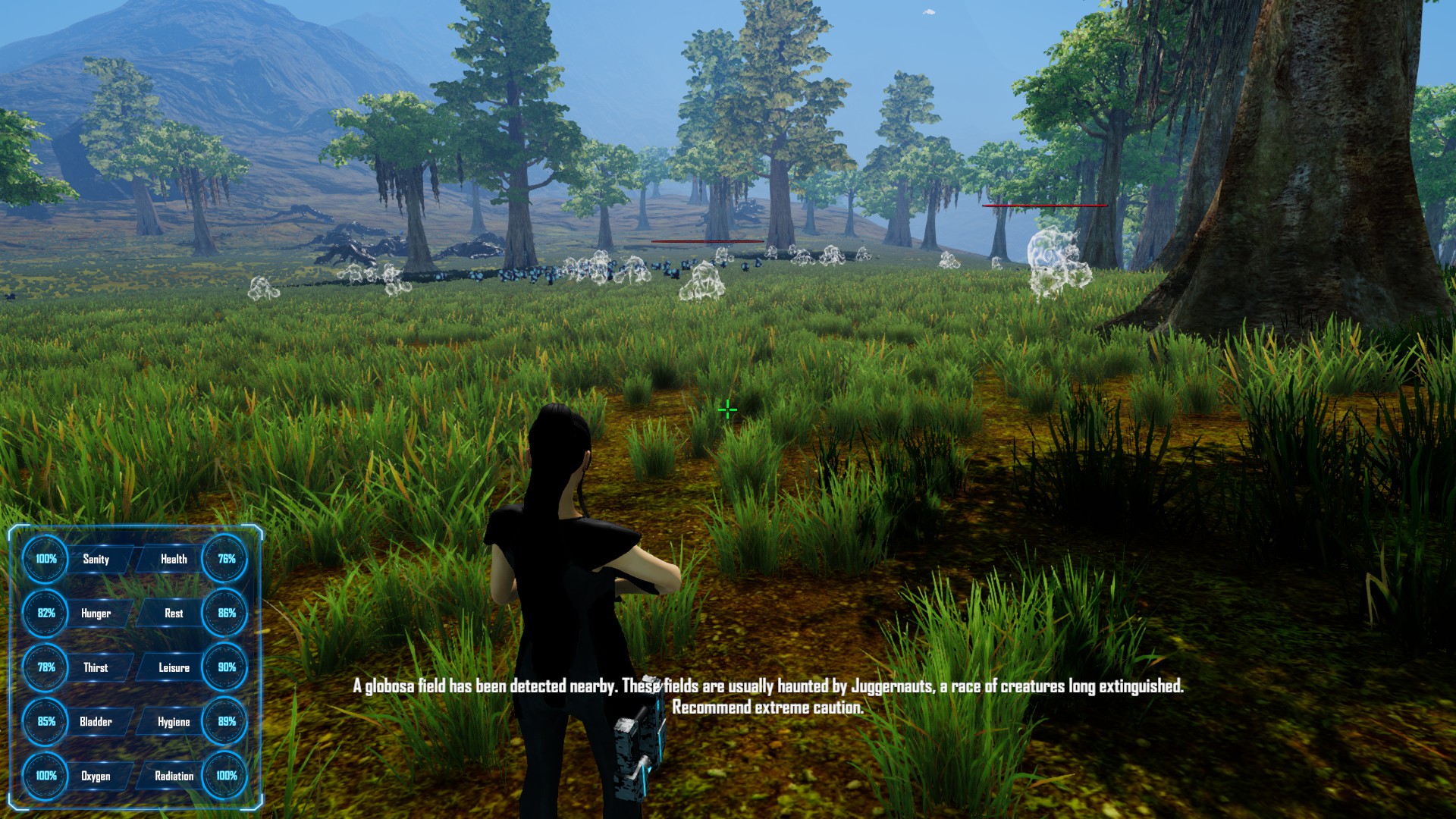
I haven’t yet seen a survival-crafting game in which permadeath works. The most recent attempt I’ve played was Fade to Silence, from Black Forest Games and published by THQ Nordic, which implemented a sort of permadeath, but with multiple, though limited, lives. In this mode it also had limited fixed resources, and thus came with an indirect time limit, as I discussed above. You can read my review here, but the relevant take-away is that this mode almost killed the game for me. And that was a game from a much larger and more experienced development team and a publisher with unfathomable amounts of money to spend on the game, at least compared to Gaia.
Does that mean that no survival-crafting game should ever have permadeath? No, of course not. But I don’t think there has been one of a reasonable scale that implemented it in a way that made it better than it would have been had it not been there at all! Even with Gaia’s current relatively small content offering, the game balance and prevalence of bugs make the permadeath option one that only someone with unlimited free real-world time and lots of patience should ever try. To everyone else, I recommend that you just leave it turned off!
Verdict
Gaia definitely has promise. As a game developed by a single person with limited experience it’s rather impressive. But at the moment it’s not good for much more than a slight distraction from other games in the genre that do the same things, but bigger and better. It has too many bugs, poor game balance, and missing features and content. In its current state I don’t really feel like sinking another ten hours into it, let alone a hundred!
Will it get there eventually? Well, no one can say for sure, but based on the developer’s work and enthusiasm so far, I’d expect so. Right now, though? I wouldn’t recommend a purchase unless you’ve played everything else in the genre and you’re hard up for some more survival-crafting goodness.
Addendum: But it’s Early Access!
I’ve had a few annoyed comments from people reading my past reviews of Early Access titles in the past, implying that I don’t understand Early Access and I should be more lenient, so I wanted to add a few words about this topic here before I sign off.
The quality of games in Early Access on Steam is immensely variable. Some developers who choose to follow the EA path put pre-alpha-level builds up in order to get visibility and community feedback as early as possible, while others hold off on even an EA release until their games are in late-beta: most definitely feature-complete and ready for a final quality assurance pass. Most are somewhere between the two.
This makes (p)reviewing an Early Access game a challenge. An honest reviewer can only review what’s available at the time, but in boiling everything down to that final Steam review decision — to recommend or not — I feel some concessions do sometimes need to be made for the state of the game; after all, there is an understanding that the game being reviewed is incomplete. Unlike a fully released (“finished”) game, an Early Access title is expected to improve.
So Early Access reviews are always a bit of a gamble, much like the decision of whether to purchase a game in EA or not. In making such a gamble, it often pays to spend some time investigating the game’s past and the developer’s public presence and attitude towards it, helping to make a more educated guess regarding what’s likely to happen with the game during the Early Access process.
In writing this review I did exactly that, reading through the game’s failed Kickstarter campaign details and updates, trawling the official forums for a while, and, of course, reading what little is currently available on the game’s Steam store pages. I even checked out the developer’s Linkedin page, which game me a slightly better understanding of where he’s coming from. All of this adds up to a favourable impression of Gaia’s future, but I can still only review what is here right now.
Even though I’ve made the hard decision to not recommend a purchase at this stage, I firmly believe that within a few months the most severe issues will have been addressed, and plans drawn up to address others. Sure, there will be new bugs and probably additions and refinements that I won’t like much — there usually are — but ultimately, I think the only way this game won’t be worth a recommendation eventually is if the developer gives up on it. And so far, at least, that seems very unlikely to happen.

